If you’re on a detox diet, Rice Revolution (呷米共食廚房) is the place to go. Situated in an off-white, narrow three-story shop on Hengyang Road (衡陽路) across from 228 Peace Memorial Park (二 二 八和平紀念公園), Rice Revolution serves home-cooked vegetarian set meals made from organic ingredients sourced from eco-friendly farms around Taiwan.
The owner Chiu Hsin-hui (邱馨慧), who is also involved in Taiwan’s Green Party (台灣綠黨), says it was her childhood dream to open a vegetarian restaurant with a social cause. As a child, Chiu spent a lot of time in hospitals being treated for allergies and asthma. Her mother was the main inspiration behind the restaurant, having introduced her to healthy eating by cooking her meals with fresh ingredients and herbs.
Chiu opened Rice Revolution in November of 2013. Its Chinese name Ga Mi, which derives from the Hoklo (more commonly known as Taiwanese) phrase “eat rice,” conjures up a homely feel.
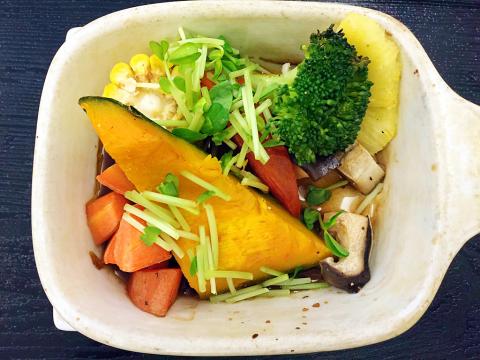
Photo: Dana Ter, Taipei Times
“We live in a city where more and more people are becoming disconnected from the earth and from understanding where our food comes from,” Chiu says. “It’s our vision to make this restaurant a platform for environmental advocacy.”
Taiwan may have its share of “activist cafes” — coffee shops that provide patrons with a forum to discuss politics — but Chiu says combining nutritious food with environmental activism is relatively new.
“Sometimes we get American and European tourists who stumble on to the restaurant by chance, but when they look around, they seem to understand our cause — more so than Taiwanese people,” she says.
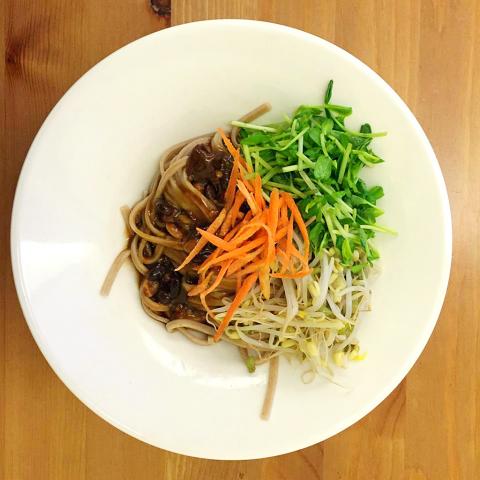
Photo: Dana Ter, Taipei Times
Chiu hopes that the restaurant will not just nourish people’s palates, but also inspire them to make a positive change in their lives. By change, she means not only eating less night market food, but more importantly, understanding that what we choose to put in our bodies affects the entirety of our ecosystem. In order to convey the message, Rice Revolution holds weekly lectures on related topics on their third floor where members of the Green Party and other environmental advocates are invited to speak.
The inside decor is sparse but warm and inviting. The first floor sells rice, sauces and herbal remedies. The second floor dining area is furnished with wooden chairs and the wall is decorated with pictures of farmers who grow the crops that diners are eating. The third floor, by contrast, is a lecture hall with light yellow walls.
In fitting with the themes of transparency and education, set menu items are accompanied with short descriptions of the ingredients and where they come from. Although the menu is entirely in Chinese, the staff is more than happy to introduce the food to you, as well as attend to dietary requests.
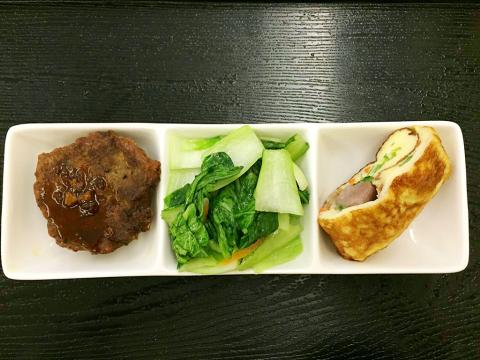
Photo: Dana Ter, Taipei Times
Perhaps the restaurant hasn’t gained popularity amongst the young hipster-activist type yet because the food is a bit bland and portions are tiny. As Chiu says, many of her customers are women in their 40s. For now, it’s still more of a place for health conscious diners or the homesick missing a home-cooked meal.
The rice with grilled mixed vegetables (NT$220) is a light and simple set meal. It’s recommended by the staff as the “healthiest” choice on the menu. Without much added sauce or garnishing, the natural flavors are brought out through contrasts in the different types of vegetables served such as pumpkin, corn, tomatoes, mushroom, broccoli and alfalfa sprouts — all grown from a farm in Yunlin County (雲林) in western Taiwan. One way to know that you’re eating a nutritious meal is by ensuring that there are different colors of food on your plate — and this set certainly achieves that. The natural sweetness of the pumpkin and corn balances the plainness of the other vegetables.
Rice Revolution’s buck wheat noodle sets (NT$220) are minimalistic in design and flavoring. There are two choices of sauce — spicy bean paste and toon sauce (香椿醬). Both are cooked with the same garnishing — shredded carrots, bean sprouts and alfalfa sprouts. The bean paste is only mildly spicy and tastes like a more subdued version of zha jiang mian (醡醬麵) or noodles with meat sauce. Only the ground pork is replaced with beans, giving it a softer texture.
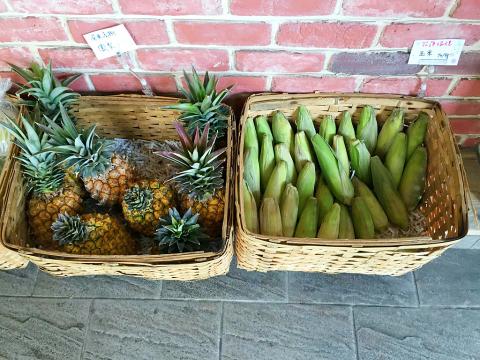
Photo: Dana Ter, Taipei Times
The noodles with toon sauce is another highly recommended menu item by the staff, although they warn that the herbal flavor can be overpowering for some. The sauce is derived from Chinese mahogany trees which are native to Taiwan. Extracts from the barks and roots of these trees are commonly used in traditional Chinese medicine because of their healing properties and potential to prevent lung cancer. When converted into a sauce though, there’s not a hint of medicinal taste. Rather, the toon takes on a soupier version of pesto with an added zest akin to onions.
The set meals come with a small side of stir-fry Chinese cabbage, warm egg rolls and chewy veggie patties — all of which complements well with rice or noodles. Drink-wise, the papaya soya milk (NT$70) is a must-try for customers who love fresh fruits and dairy. It’s cool, soothing and helps to wash down the meal.
Rice Revolution is conceptually sound, but I wish their portions were bigger and had a little more flavor. Perhaps it’ll be a while before healthy eating establishments, like activist cafes, becomes cool amongst Taiwanese youth. But change needs to start somewhere.
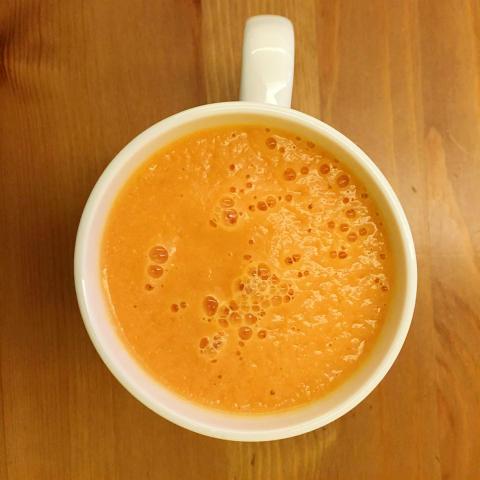
Photo: Dana Ter, Taipei Times

May 11 to May 18 The original Taichung Railway Station was long thought to have been completely razed. Opening on May 15, 1905, the one-story wooden structure soon outgrew its purpose and was replaced in 1917 by a grandiose, Western-style station. During construction on the third-generation station in 2017, workers discovered the service pit for the original station’s locomotive depot. A year later, a small wooden building on site was determined by historians to be the first stationmaster’s office, built around 1908. With these findings, the Taichung Railway Station Cultural Park now boasts that it has

The latest Formosa poll released at the end of last month shows confidence in President William Lai (賴清德) plunged 8.1 percent, while satisfaction with the Lai administration fared worse with a drop of 8.5 percent. Those lacking confidence in Lai jumped by 6 percent and dissatisfaction in his administration spiked up 6.7 percent. Confidence in Lai is still strong at 48.6 percent, compared to 43 percent lacking confidence — but this is his worst result overall since he took office. For the first time, dissatisfaction with his administration surpassed satisfaction, 47.3 to 47.1 percent. Though statistically a tie, for most

As Donald Trump’s executive order in March led to the shuttering of Voice of America (VOA) — the global broadcaster whose roots date back to the fight against Nazi propaganda — he quickly attracted support from figures not used to aligning themselves with any US administration. Trump had ordered the US Agency for Global Media, the federal agency that funds VOA and other groups promoting independent journalism overseas, to be “eliminated to the maximum extent consistent with applicable law.” The decision suddenly halted programming in 49 languages to more than 425 million people. In Moscow, Margarita Simonyan, the hardline editor-in-chief of the

Six weeks before I embarked on a research mission in Kyoto, I was sitting alone at a bar counter in Melbourne. Next to me, a woman was bragging loudly to a friend: She, too, was heading to Kyoto, I quickly discerned. Except her trip was in four months. And she’d just pulled an all-nighter booking restaurant reservations. As I snooped on the conversation, I broke out in a sweat, panicking because I’d yet to secure a single table. Then I remembered: Eating well in Japan is absolutely not something to lose sleep over. It’s true that the best-known institutions book up faster